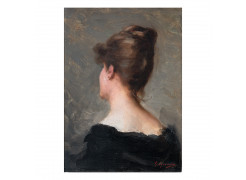Additional info:
The painter Nicolae Grigorescu is by far a symbol of Romania when it comes to art. As a Romanian interwar painter, he is definitely the best-known abroad. He is considered to be the master of all Romanian painters from that period and the one who created an important path in the history of Romanian art. Grigorescu was born into a large family with very modest financial resources. After his father’s death, he started selling his small painted landscapes at the village market to help his family. In 1843 he moved with his family to a peripheral neighbourhood of Bucharest. At the age of fourteen, after finishing two primary classes, Grigorescu wanted to go to Paris. Ambitious and hardworking, he applied for a scholarship, but unfortunately didn’t receive it. Meanwhile, he started to paint religious paintings and one year later he became one of the most popular church painters. For many years, he painted churches in Romania and worked with the painter Anton Chladek. In 1861, his career as a church painter ended, given that he had acquired the financial resources to pursue his dream. He worked on his skills and enriched his visual culture by studying with great French artists, making an exquisite impression on Parisian critics with his talent. In Paris and Barbizon he created a series of remarkable works, both landscapes and portraits. Returning to Romania, Grigorescu had many successful exhibitions. In 1877, he was preparing to return to Paris when he received Brătianu’s call to go on the battlefield. After the war, Grigorescu built his studio in Câmpina where he lived and created for the rest of his life.
-
Peter Klasen
b. 1935 -
Jelena Trpković
b. Serbia, 1952 -
Ștefan Pelmuș
b. Valea Călugărească, Romania, 1949 -
Ion Popescu Negreni
Negreni, Romania, 1907 - Bucharest, Romania, 2001 -
Jelena Bulajić
b. Serbia , 1990

